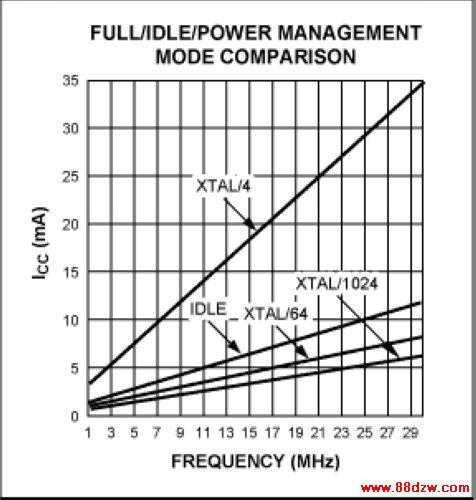Microcontrollers Improve Power
[09-13 17:03:33] 来源:http://www.88dzw.com 控制技术 阅读:8436次
文章摘要:Figure 7. Full/Idle/Power Management Mode Comparison.Using Interrupts with PMM One possible consequence of using an internal clock divisor is that interrupt latencies may be greatly increased. In addition, slowing the internal timers would affect the ability of the 8051 serial ports to generate or s
Microcontrollers Improve Power,标签:计算机控制技术,工厂电气控制技术,http://www.88dzw.com
Figure 7. Full/Idle/Power Management Mode Comparison.
Using Interrupts with PMM
One possible consequence of using an internal clock divisor is that interrupt latencies may be greatly increased. In addition, slowing the internal timers would affect the ability of the 8051 serial ports to generate or synchronize with a standard baud rate. This could seriously interfere with the device's ability to respond to external stimuli. One solution is to incorporate a feature that automatically restores the device to full operation when an external interrupt or serial port activity is recognized. Such a mechanism has been implemented in the DS87C520. That device's Switchback feature allows the device to respond quickly to external interrupts. As soon as the interrupt is acknowledged, the device will automatically switch back to full speed (divide by 4) without software intervention.The serial ports operate in a similar fashion. Upon receipt of a falling edge (start bit) on a serial port reception pin, the device will automatically switch back to full speed (divide by 4). Because this happens immediately at the start of the transmission, the device will be at full speed to correctly receive the rest of the transmission. With a traditional 8051 architecture, the only way to use the serial ports in a low-power configuration was with the Idle mode. The use of Power Management Modes provides a lower power alternative.
Improving Burst Mode Operation
A common mode of operation in power-conscious designs is to have the system awake from Stop mode, perform a burst of activity, and then return to Stop mode. One way to decrease power consumption in such a system is to increase the operating frequency. At first, this may seem counter-intuitive. For the time in which the device is operating, it will consume more power than a system operating at a lower frequency. The quiescent current consumed while the system is operating, however, is not a function of frequency. In the final system design, energy is typically evaluated to determine battery life. This distinction is important when evaluating a high-performance microcontroller because it combines the concept of time and processing power. If the product of power and time is smaller for a given system, then it will require less energy, regardless of the individual terms. In many instances, it can be shown that a high-speed microcontroller can actually reduce energy consumption by running fast for short periods, as opposed to running more slowly for a longer period of time.This can be demonstrated by re-examining Figure 7. Assume that upon resuming from Stop mode, a DS87C520 must read an I/O port, perform a mathematical computation, and output the result to another port, requiring 500 machine cycles of CPU time. From the figure, the current consumption is 12.4mA at 10MHz, and 34.6mA at 30MHz. Table 1 summarizes the results of the task at both speeds. As can be seen from the table, operation at 30MHz is the most energy efficient, with a more than 6% reduction in energy consumed.
上一页 [1] [2] [3] [4] [5] [6] [7] [8] [9] 下一页
Tag:控制技术,计算机控制技术,工厂电气控制技术,控制技术
《Microcontrollers Improve Power》相关文章
- › MICRF501 300~500 MHz收发器
- › MICRF500 FSK l000~700 MHz收发器
- › Microcontrollers Improve Power
- › Micronas最新控制IC优化平板显示器图像质量
- › Micronas 推出FRC 94xyM全高清帧率转换IC
- › Microchip推出新型低成本数字信号控制器系列
- 在百度中搜索相关文章:Microcontrollers Improve Power
- 在谷歌中搜索相关文章:Microcontrollers Improve Power
- 在soso中搜索相关文章:Microcontrollers Improve Power
- 在搜狗中搜索相关文章:Microcontrollers Improve Power
分类导航
最新更新




 当前位置:
当前位置: